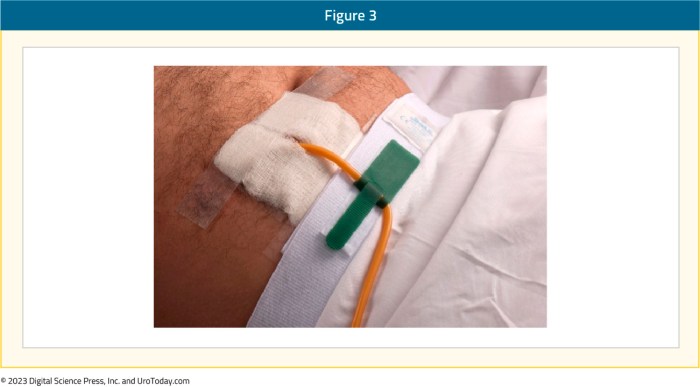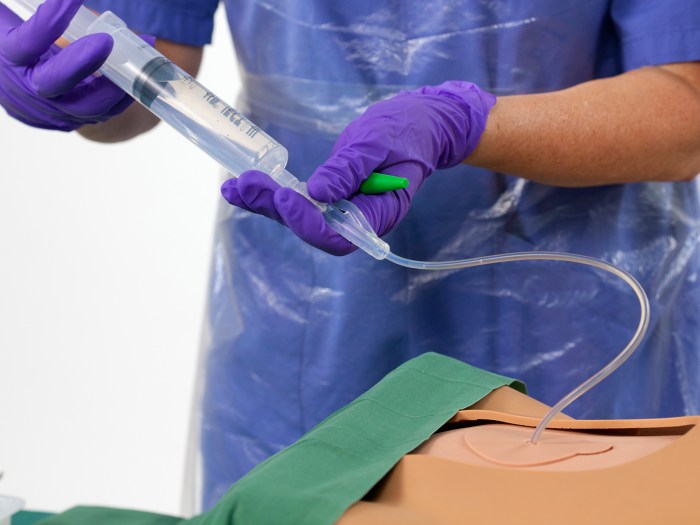Can lpn change suprapubic catheter – Exploring the scope of practice for Licensed Practical Nurses (LPNs) in the management of suprapubic catheters, this article delves into the legal and regulatory considerations, specific tasks permitted, assessment and preparation procedures, step-by-step guide for catheter change, post-procedure care, documentation requirements, and patient education.
By understanding their role and responsibilities, LPNs can effectively contribute to the safe and effective care of patients with suprapubic catheters.
LPNs play a vital role in providing comprehensive care to patients with suprapubic catheters, ensuring their well-being and promoting optimal outcomes.
Scope of Practice
Licensed Practical Nurses (LPNs) play a crucial role in the healthcare system, providing essential care to patients. Their scope of practice includes specific tasks related to suprapubic catheter care, as Artikeld by legal and regulatory guidelines.
Legal and Regulatory Considerations
- LPNs must adhere to state regulations and facility policies regarding suprapubic catheter care.
- They are authorized to perform certain tasks within their scope of practice, including assessment, preparation, and post-procedure care.
- LPNs are responsible for maintaining patient safety and ensuring proper catheter management.
Specific Tasks for LPNs
- Assessing patient’s condition and catheter status
- Preparing the patient and equipment for catheter change
- Monitoring for signs of infection or complications
- Providing patient education and discharge planning
Assessment and Preparation
Prior to suprapubic catheter change, a thorough assessment of the patient and catheter is essential.
Patient Assessment
- Review patient’s medical history and current symptoms
- Inspect the catheter insertion site for redness, swelling, or drainage
- Assess the patient’s comfort level and ability to tolerate the procedure
Equipment Preparation, Can lpn change suprapubic catheter
- Gather necessary supplies, including sterile gloves, gauze, antiseptic solution, and a new suprapubic catheter
- Ensure that the equipment is clean and in good working order
- Prepare the patient’s environment by providing privacy and minimizing distractions
Procedure

The suprapubic catheter change procedure should be performed with strict adherence to infection control measures.
Step-by-Step Guide
- Don sterile gloves and position the patient in a comfortable supine position.
- Cleanse the catheter insertion site with antiseptic solution.
- Inflate the balloon of the new catheter with sterile water.
- Gently insert the new catheter into the suprapubic tract.
- Deflate the balloon and secure the catheter to the patient’s abdomen.
- Dispose of the old catheter and supplies appropriately.
Troubleshooting
- Difficulty inserting the new catheter: Check for obstructions or kinks in the catheter.
- Leakage around the catheter insertion site: Ensure the balloon is inflated properly and the catheter is securely fastened.
- Patient discomfort: Adjust the catheter position or provide pain medication as needed.
Post-Procedure Care

After the suprapubic catheter change, proper post-procedure care is essential to prevent complications.
Essential Steps
- Monitor the patient for signs of infection, such as fever, chills, or cloudy urine.
- Change the catheter dressing as needed, maintaining a clean and dry insertion site.
- Encourage the patient to drink plenty of fluids to maintain hydration.
- Provide patient education on catheter care and potential complications.
Complications
- Urinary tract infection (UTI)
- Catheter blockage
- Skin irritation or breakdown around the insertion site
Documentation and Education: Can Lpn Change Suprapubic Catheter
Accurate documentation and patient education are crucial for effective suprapubic catheter management.
Documentation Requirements
- Record the date and time of the catheter change.
- Document the patient’s condition and any complications encountered.
- Note the type and size of the new catheter inserted.
- Include any patient education provided.
Patient Education
- Instruct the patient on proper catheter care, including changing the dressing and monitoring for signs of infection.
- Discuss the importance of maintaining hydration.
- Provide information on when to seek medical attention if complications arise.
- Offer support and resources to the patient and their family.
General Inquiries
What are the legal considerations for LPNs changing suprapubic catheters?
LPNs must adhere to state regulations and facility policies regarding their scope of practice, which may vary depending on the jurisdiction.
What are the specific tasks that LPNs can perform related to suprapubic catheter care?
LPNs are typically responsible for assessing the patient’s condition, preparing the patient and equipment, changing the suprapubic catheter, monitoring for complications, and providing patient education.
What are the key steps involved in changing a suprapubic catheter?
The procedure involves gathering necessary supplies, assessing the patient’s condition, cleaning the insertion site, removing the old catheter, inserting the new catheter, securing the catheter, and monitoring the patient for any adverse reactions.